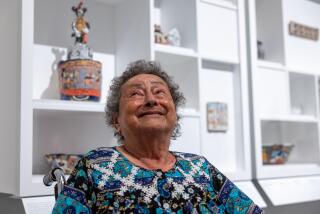Pioneering L.A. performance artist Rachel Rosenthal dies at 88
Pioneering performance artist Rachel Rosenthal wasn’t out to simply shock audiences, though her performances were filled with arresting moments.
She had hot wax poured over her shaved head, buried herself in artificial snow, read alternately from the ancient Kabbalah and car magazines, and shared the stage with more than 40 animals, including her beloved pet rat, who could often be found perched on her shoulder when she was off-stage.
But no matter how varied her performances — which ranged from solo pieces to ones that had 50 actors — her politically flavored works, spiked with humor, had an overriding theme.
“It’s about our relationship to the Earth. It deals with who we are as a species and how we belong on this planet,” she said in a 1995 Times interview.
And what was her assessment of that relationship?
“In a word, lousy.”
Rosenthal, 88, who was performing well into her 70s, died Sunday at her home in West Los Angeles. She had been in declining health and died of congestive heart failure, said Kate Noonan, managing director of the Rachel Rosenthal Company, which presents improvised works.
Noonan said Rosenthal, though frail, attended a company rehearsal as recently as last week.
Rosenthal, who cut an exotic figure with her bald head (she had it shaved during a 1981 performance and kept it that way), colorful makeup and multiple earrings, was a familiar presence on the arts scene in Los Angeles, especially in the 1970s, 1980s and 1990s when she performed at a variety of venues, including the Museum of Contemporary Art.
She also presented works in numerous cities in Europe and in New York, where her “Rachel’s Brain” won an off-Broadway Obie award in 1989.
Her pieces made feminist statements and took up the cause of animal rights — Rosenthal was known to leave rehearsals to help find a home for an abandoned pet.
Her impassioned works didn’t always get great reviews, but even critics who found her pieces disjointed praised her ability to create moments of stillness among chaos.
“When she grabs your attention for individual fragments of the narrative,” Nancy Churnin wrote in The Times in 1991 in a review of Rosenthal’s “Pangaean Dreams,” “she grabs it and shakes it like Jove playing with thunderbolts.”
Writing in the New York Times about the same work, Stephen Holden said, “Rosenthal can be growlingly ominous.... She can also be very funny.”
Typical of Rosenthal, the piece — which was performed in Los Angeles, San Diego, New York and other cities — drew from a panoply of narratives, weaving together Earth geography before the breakup of the continents, her own aging body, birth, death and the Persian Gulf War.
Rosenthal often used projections, movies and sound imaging in the pieces. They all came together at a point in “Pangaean Dreams” in which she held a white robe around her head that suddenly became a screen for projections.
“As the images of the Earth move around that head,” Churnin wrote, “one gets an impression of one person as a distinct island in a world of movement.”
Movement was always a primary factor for Rosenthal. She was born in Paris on Nov. 9, 1926, into a wealthy Russian Jewish family. Her father was a successful gem merchant and one of the top philanthropists in the country.
But during World War II, the family fled the Nazis, losing much of its fortune. The Rosenthals landed in Portugal, then Rio de Janeiro and finally in New York, where Rachel Rosenthal graduated from the High School of Music and Art.
She was a dancer and fell in with an avant garde crowd at a time of artistic fervent in the 1950s. She grew close to painters Robert Rauschenberg and Jasper Johns, and joined the dance company headed by Merce Cunningham.
The person who most influenced her was composer and writer John Cage. She was drawn to his creations derived from chance operations, including the I Ching.
“Chance is very risky for some people,” she said in a 2009 Times interview. “To feel comfortable with chance gives you a one-upmanship over the lot. It gives you courage; you are not afraid to make mistakes.”
When she came to Los Angeles in the mid-1950s, she started a theater group, Instant Theatre, that used chance operations to create performances not only for adults, but also for children. Indeed, it was the children’s performances that sustained the company, financially, during its decade-long run.
Her more edgy work began in the 1970s. Although her works were generally seen by only a few hundred people at a time, Rosenthal was also seen by millions by picking up occasional roles on television sitcoms and other programs. She played an artist, for laughs, on “Frasier” in 1993, a tarot card reader on “Ellen” in 1998 and even had a part in the western “The Virginian” in 1970.
“She didn’t go out and audition,” Noonan said. “People would think of her and ask her to appear, and she always said yes. She had a great time.”
Rosenthal’s marriage to actor King Moody ended in divorce and she had no immediate family survivors. Her last dog, Fanny, will be cared for by Noonan.
david.colker@latimes.com
More to Read
Start your day right
Sign up for Essential California for the L.A. Times biggest news, features and recommendations in your inbox six days a week.
You may occasionally receive promotional content from the Los Angeles Times.







